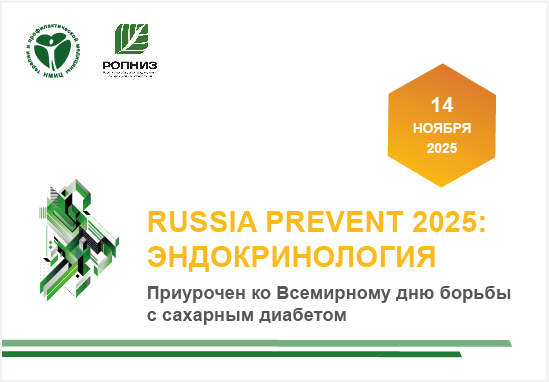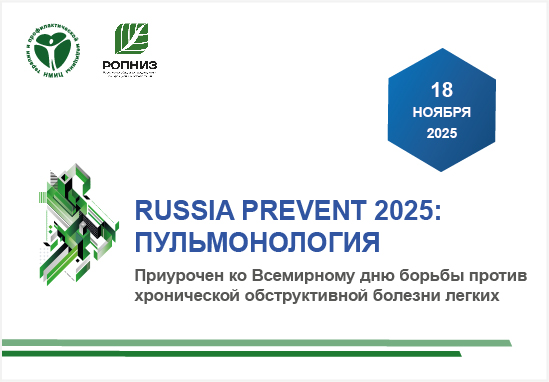The prevalence of risk factors for chronic noncommunicable diseases among medical specialists in the Tomsk region
https://doi.org/10.15829/1728-8800-2019-2239
Abstract
Aim. To determine the prevalence and structure of risk factors (RF) for chronic noncommunicable diseases (CNCD) medical specialists in the Tomsk Region depending on labor parameters, gender, residence and specialty.
Material and methods. As part of the study, specialists filled out questionnaires that included questions related to their labor activity, as well as a questionnaire made up on basis of methodological recommendations “Monitoring of risk factors for chronic noncommunicable diseases in practical healthcare”. The questionnaire was submitted in electronic form and posted on the website http://www.golosaonline.ru/medto.
Results. Medical specialists in the Tomsk region revealed a high prevalence of such RFs of CNCD as improper feeding and sedentary lifestyle, as well as overweight. We recorded that these RFs are most common among surgical specialties.
Conclusion. The study showed that there is a need for practical recommendations for medical specialists on leveling the individual RFs of CNCD.
About the Authors
O. S. KobyakovaRussian Federation
Tomsk
I. A. Deev
Russian Federation
Tomsk
E. S. Kulikov
Russian Federation
Tomsk
A. A. Almikeeva
Russian Federation
Tomsk
I. D. Pimenov
Russian Federation
Tomsk
N. P. Garganeeva
Russian Federation
Tomsk
E. A. Starovoitova
Russian Federation
Tomsk
T. A. Zagromova
Russian Federation
Tomsk
M. A. Balaganskaya
Russian Federation
Tomsk
N. A. Kirillova
Russian Federation
Tomsk
References
1. Popechitelev EP, Pekker YS, Novikova TV. The problem of assessing the adaptive capacity of the human operator. Bulletin of Siberian Medicine. 2018;17(3):242-6. (In Russ.) doi:10.20538/1682-0363-2018-3-242-246.
2. Kobyakova OS, Deev IA, Kulikov ES, et al. Burnout in doctors and medical errors. Is there a connection? Social aspects of population health. 2016;47(1):5. (In Russ.) Кобякова О. С., Деев И. А., doi:10.21045/2071-5021-2016-47-1-5.
3. World Health Organization. Programme budget 2018-2019. World Health Organization 2017. (in Russ.) https://apps.who.int/iris/handle/10665/272406.
4. Bessonova TI, Shkatova EYU. Morbidity of dental specialists. Social aspects of population health. 2016;49(3):3. (In Russ.) Бессонова Т. И., Шкатова Е. Ю. Заболеваемость медицинских работников стоматологического профиля. Социальные аспекты здоровья населения. 2016;49(3):3. doi:10.21045/2071-5021-2016-49-3-3.
5. Pedersen AF, Sorensen JK, Bruun NH, et al. Risky alcohol use in Danish physicians: Associated with alexithymia and burnout? Drug Alcohol Depend. 2016;160:119-26. doi:10.1016/j.drugalcdep.2015.12.038.
6. The order of the Ministry of Healthcare organization of the Russian Federation December 20, 2012 N 1183n “On approval of the nomenclature of positions of medical workers and pharmaceutical workers”, (in Russ.) http://www.consultant.ru/cons/cgi/online.cgi?req=doc&base=LAW&n=167629&fld=134&dst=1000000001,0&rnd=0.8163633700230948#07998008993404007
7. Balanova YuA, Imaeva AE, Koncevaya AV, et al. Epidemiological monitoring of risk factors for chronic noncommunicable diseases in health care practice at the regional level. Guidelines edited Boytsova SA 2016;111 p. (In Russ.) doi:10.17116/profmed2016metod01.
8. Sun J, Yi H, Liu Z, et al. Factors associated with skipping breakfast among Inner Mongolia Medical students in China. BMC Public Health 2013; 17(13): 42. doi:10.1186/1471-2458-13-42.
9. Kislov AI, Volkova EV. Features of tobacco prevalence and clinic among doctors of therapeutic and surgical profiles. University proceedings. Volga region. Medical sciences. 2012;1:130-7. (In Russ.)
10. Shahbazi S, Arif AA, Portwood SG, Thompson ME. Risk factors of smoking among health care professionals. J Prim Care Community Health. 2014;5(4):228-33. doi:10.1177/2150131914527618.
11. Mittal TK, Cleghorn CL, Cade JE, et al. A cross-sectional survey of cardiovascular health and lifestyle habits of hospital staff in the UK: Do we look after ourselves? Eur J Prev Cardiol. 2018;25(5):543-50. doi:10.1177/2047487317746320.
12. Kobalava ZhD, Kotovskaya YuV, Shalnova SA. The results of the Russian multi-centre scientific and educational programme Russian Doctors' Health Cardiovascular Therapy and Prevention. 2010;9(4):12-24. (In Russ.)
13. Tolmachev DA, Sysoev PG, Lebedev AV. Characteristics of the way of life and working conditions of doctors of functional diagnostics. International Research J. 2017;63(9):40-2. (In Russ.) doi:10.23670/irj.2017.63.078.
14. Suija K, Pechter U, Maaroos J, et al. Physical activity of Estonian family doctors and their counselling for a healthy lifestyle: a cross-sectional study. BMC Fam. Pract. 2010; 18(11):48. doi:10.1186/1471-2296-11-48.
15. Bayanova NA, Borschuk EL, Smirnov SA. Features of the lifestyle of district physicians. Vyatka Medical Bulletin. 2017;2(54):54-8. (In Russ.)
Review
For citations:
Kobyakova O.S., Deev I.A., Kulikov E.S., Almikeeva A.A., Pimenov I.D., Garganeeva N.P., Starovoitova E.A., Zagromova T.A., Balaganskaya M.A., Kirillova N.A. The prevalence of risk factors for chronic noncommunicable diseases among medical specialists in the Tomsk region. Cardiovascular Therapy and Prevention. 2020;19(1):32-39. (In Russ.) https://doi.org/10.15829/1728-8800-2019-2239

























































